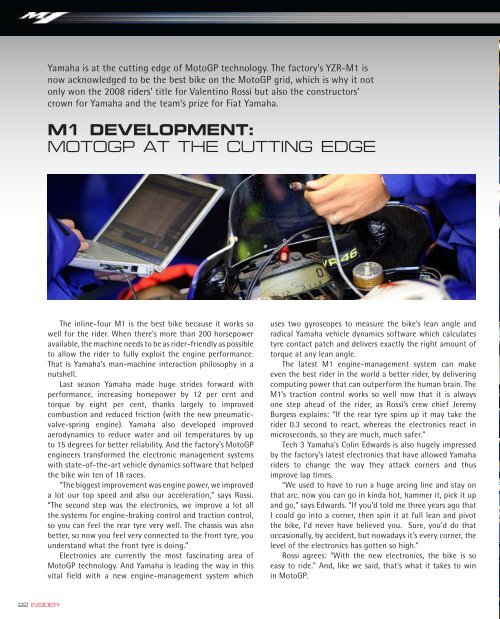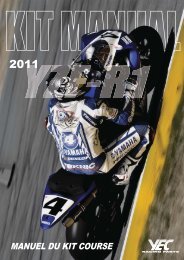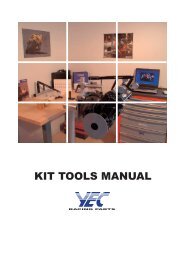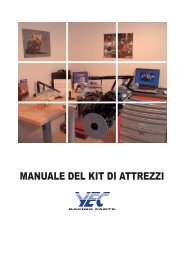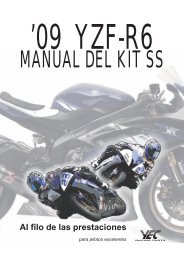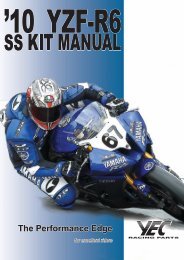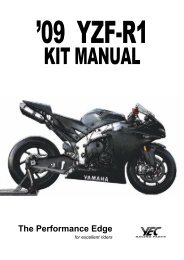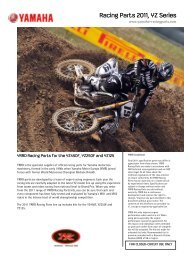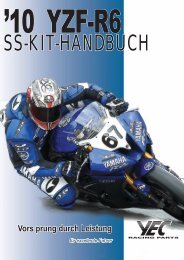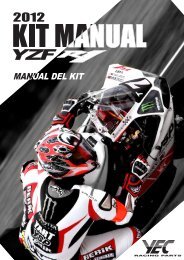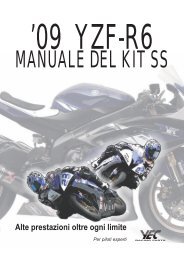The official Yamaha racing magazine - Yamaha-Racingparts
The official Yamaha racing magazine - Yamaha-Racingparts
The official Yamaha racing magazine - Yamaha-Racingparts
You also want an ePaper? Increase the reach of your titles
YUMPU automatically turns print PDFs into web optimized ePapers that Google loves.
22 INSIDER<br />
<strong>Yamaha</strong> is at the cutting edge of MotoGP technology. <strong>The</strong> factory’s YZR-M1 is<br />
now acknowledged to be the best bike on the MotoGP grid, which is why it not<br />
only won the 2008 riders’ title for Valentino Rossi but also the constructors’<br />
crown for <strong>Yamaha</strong> and the team’s prize for Fiat <strong>Yamaha</strong>.<br />
M1 DEvElOPMENT:<br />
MOTOGP AT ThE CUTTING EDGE<br />
<strong>The</strong> inline-four M1 is the best bike because it works so<br />
well for the rider. When there’s more than 200 horsepower<br />
available, the machine needs to be as rider-friendly as possible<br />
to allow the rider to fully exploit the engine performance.<br />
That is <strong>Yamaha</strong>’s man-machine interaction philosophy in a<br />
nutshell.<br />
Last season <strong>Yamaha</strong> made huge strides forward with<br />
performance, increasing horsepower by 12 per cent and<br />
torque by eight per cent, thanks largely to improved<br />
combustion and reduced friction (with the new pneumaticvalve-spring<br />
engine). <strong>Yamaha</strong> also developed improved<br />
aerodynamics to reduce water and oil temperatures by up<br />
to 15 degrees for better reliability. And the factory’s MotoGP<br />
engineers transformed the electronic management systems<br />
with state-of-the-art vehicle dynamics software that helped<br />
the bike win ten of 18 races.<br />
“<strong>The</strong> biggest improvement was engine power, we improved<br />
a lot our top speed and also our acceleration,” says Rossi.<br />
“<strong>The</strong> second step was the electronics, we improve a lot all<br />
the systems for engine-braking control and traction control,<br />
so you can feel the rear tyre very well. <strong>The</strong> chassis was also<br />
better, so now you feel very connected to the front tyre, you<br />
understand what the front tyre is doing.”<br />
Electronics are currently the most fascinating area of<br />
MotoGP technology. And <strong>Yamaha</strong> is leading the way in this<br />
vital field with a new engine-management system which<br />
uses two gyroscopes to measure the bike’s lean angle and<br />
radical <strong>Yamaha</strong> vehicle dynamics software which calculates<br />
tyre contact patch and delivers exactly the right amount of<br />
torque at any lean angle.<br />
<strong>The</strong> latest M1 engine-management system can make<br />
even the best rider in the world a better rider, by delivering<br />
computing power that can outperform the human brain. <strong>The</strong><br />
M1’s traction control works so well now that it is always<br />
one step ahead of the rider, as Rossi’s crew chief Jeremy<br />
Burgess explains: “If the rear tyre spins up it may take the<br />
rider 0.3 second to react, whereas the electronics react in<br />
microseconds, so they are much, much safer.”<br />
Tech 3 <strong>Yamaha</strong>’s Colin Edwards is also hugely impressed<br />
by the factory’s latest electronics that have allowed <strong>Yamaha</strong><br />
riders to change the way they attack corners and thus<br />
improve lap times.<br />
“We used to have to run a huge arcing line and stay on<br />
that arc, now you can go in kinda hot, hammer it, pick it up<br />
and go,” says Edwards. “If you’d told me three years ago that<br />
I could go into a corner, then spin it at full lean and pivot<br />
the bike, I’d never have believed you. Sure, you’d do that<br />
occasionally, by accident, but nowadays it’s every corner, the<br />
level of the electronics has gotten so high.”<br />
Rossi agrees: “With the new electronics, the bike is so<br />
easy to ride.” And, like we said, that’s what it takes to win<br />
in MotoGP.<br />
Masao Furusawa:<br />
“ We never<br />
stop development<br />
in MotoGP”<br />
“At <strong>Yamaha</strong> we have always recognised that<br />
MotoGP is not only about <strong>racing</strong> – it is also an<br />
advanced research and development arena for<br />
future <strong>Yamaha</strong> supersport bikes, that’s why it is so<br />
important to us. When we achieve good results, we<br />
know that our work will benefit the bikes we sell to<br />
customers, that’s one reason we were so happy to<br />
win the 2008 MotoGP World Championship.<br />
Our MotoGP and supersport staff groups<br />
work very closely together. <strong>The</strong> supersport group<br />
ride the YZR-M1 to experience and analyse its<br />
performance. <strong>The</strong>y also have frequent discussions<br />
with the MotoGP group about how they can use<br />
MotoGP know-how to improve the R1. Also, some<br />
staff from the MotoGP group have been moved<br />
to the supersport group to help this transfer of<br />
technology. Rossi wasn’t specifically involved in<br />
development of the R1, but the good work he does<br />
on the M1 helps supersport development.<br />
Many supersport bikes only look the same as<br />
MotoGP bikes, but the latest YZF-R1 is closely<br />
related to the M1 because it uses the same<br />
crossplane crankshaft configuration which gives<br />
it a very specific engine character. It was a simple<br />
thing to decide that the R1 supersport bike would<br />
benefit from the M1’s crossplane crankshaft<br />
concept.<br />
Of course, we realise that not all MotoGP<br />
technology can be transferred to supersport bikes<br />
like the R1 and R6; for example pneumatic-valve<br />
systems and carbon brakes are technologies which<br />
I believe will remain racetrack technologies.<br />
We never stop development in MotoGP, we<br />
always want to make the M1 a better bike, with<br />
more features. And we hope that what we learn<br />
in MotoGP will help us to keep improving our<br />
supersport machines.”<br />
INSIDER 23


